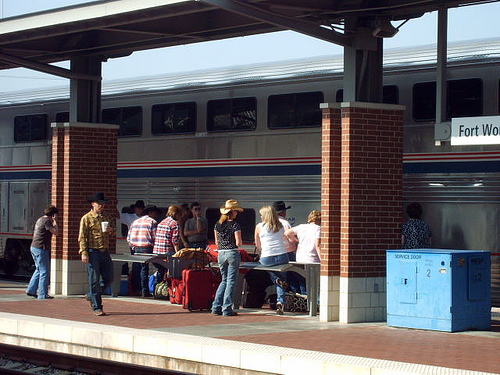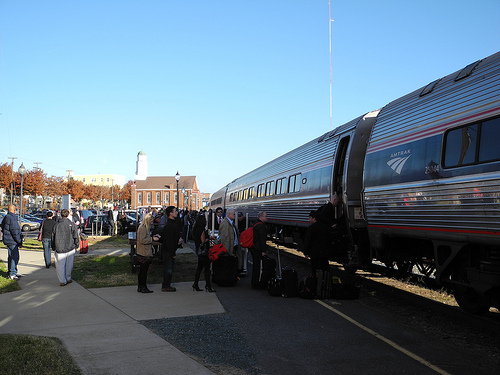Happening Now
Americans *do* ride trains
September 3, 2013
Written By Colin Leach
A recent feature on The Economist’s blog attempted to answer the age-old question of why Americans do not travel by train as much as Europeans. But in doing so, the paper did not take into account certain realities concerning Americans’ changing travel preferences as well as current use of rail travel. Ultimately, The Economist’s analysis presents an incomplete picture that is based on an imperfect understanding of passenger rail demand.

The blog begins by arguing that train service outside of the Northeast, California, and Midwest Corridor is unpopular due to low population density and large distances between cities. Here, we find passenger train detractors’ textbook fallacy: “America is too big for long-distance trains.” First, distances between major cities east of the Mississippi River and along the West Coast are comparable to those in Europe. Secondly, as NARP argued in its 2012 white paper on long-distance service, most passengers do not take the train from a route’s origin to its terminus. On the Southwest Chief, for example, only 8% of passengers take the train from Chicago to Los Angeles. 64%, however, take the train from either endpoint to an intermediate stop, whereas 28% travel between intermediate points. Long-distance trains are particularly critical for rural municipalities, which have been losing access to air and intercity bus services for some time.

Amtrak’s most recent ridership statistics show that Americans understand the value of long-distance trains. Trains such as theCapitol Limited and the Texas Eagle both saw growth in excess of 6% compared to the first six months of 2012, and others, such as theCardinal, enjoyed double-digit increases in ridership. Rather than dismissing long-distance trains as an outmoded means of travel, more and more Americans are rediscovering the utility of passenger trains every day.
While it is true that there are difficulties inherent in passenger trains’ use of tracks owned by freight railroads that move heavy volumes of freight over them, this should not be seen as an insurmountable obstacle to adding new passenger routes and frequencies, or to speeding existing trains, as long as Amtrak, the federal government and states work as partners with freight carriers. Through give-and-take negotiations and recognition of host railroads’ needs, states like Virginia, Illinois, North Carolina and Maine have earned freight railroads’ cooperation in the improvement of passenger service.

While free highways and affordable air service are plentiful now, this will not be the case indefinitely. Gas prices are on a long-term upward trend, and legislatures’ refusals to raise the gas tax mean that we are likely to see the increased use of tolling and similar mechanisms simply to raise the amount of money needed to maintain existing highways—while the road lobby continues to push for their costly expansion. Remember: starting a short-distance passenger train corridor costs about the same as building a single highway interchange. Plus, congestion, delays and hassles plaguing both auto and air travel, and rising concern with the environmental impacts of both, particularly amongst Millennials, are all contributing towards renewed interest in trains and transit. These trends show no signs of reversing, and the era of cheap gas and cheap airline tickets won’t last much longer. Not to mention the degree to which auto and air travel are massively subsidized by general taxpayers.
Finally, American passenger rail also suffers from what The Economist terms a “political battle over rail that doesn’t quite exist in other countries”. President Obama’s backing of new high speed rail lines supposedly causes conservatives to reflexively oppose rail funding.
This argument is based on a confused definition “high speed rail”. While it is true that the White House has endorsed plans for 220-mph service in California, Florida, and other states, much of the work done in “high speed rail” is actually more accurately termed “higher speed rail”, or, as the Federal Railroad Administration terms it, “emerging high speed rail” or, as the American Public Transportation Association puts it, “high-performance passenger rail” (HPPR). Unlike “high speed rail”, HPPR describes services operating on existing rail lines at a consistent speed between 79 and 110 mph. A majority of the projects funded by the Administration’s High Speed Intercity Passenger Rail Program (HSIPR)are better categorized as HPPR, as these projects increase speeds and cut travel times on existing services.
Unlike 125 mph+ “high speed” projects that have encountered planning difficulties due to the initial costs of development and design, HPPR finds many supporters and few objectors. States such as Illinois, Missouri, Michigan, Virginia, Washington, and Oregon have partnered with host freight railroads and the federal government to improve track quality and increase speeds, which in turn decreases travel time and allows for more frequencies. Faster travel times and smoother rides have brought passengers back to the rails in record numbers.
Consider the case of the Missouri River Runner. Operating on Union Pacific’s line between St. Louis and Kansas City, the train has benefited from HSIPR grants that have funded needed track and signaling improvements along the length of the route. So far, Missourians have responded positively to the improved service. The Missouri Department of Transportation announced that the train’s ridership reached a record high of 197,000 passengers in fiscal year 2012-2013, with revenue topping out at a record $5.4 million. Most critically, these improvements have also allowed for a record 90% on-time performance. As rail advocates know, reliable service is crucial to attracting new ridership.

Further proof of the broad political appeal of HPPR can be seen in Virginia. The Republican-controlled legislature and Republican Governor Bob McDonnell most recently approved a transportation package that includes a dedicated funding source for Amtrak Virginia’s trains between Washington and Newport News and Norfolk. This dedicated source of funding has also made it possible for the state to announce a planned extension of service to Roanoke, with the possibility of an extension to Bristol by the end of the decade. Thus, even for staunch conservatives like McDonnell and the Virginia General Assembly, rail isn’t a political football: it’s just part of a sound, balanced transportation policy.
Contrary to The Economist’s findings, Americans are riding trains in greater numbers than ever before. Despite the blog’s claim, Americans do not need to wait for the future opening of California High Speed Rail to see the success and utility of passenger trains.
Observing rail’s success is as simple as a trip to your local Amtrak station at train time. The crowds speak for themselves.
-- Colin Leach and Malcolm Kenton
Photo Credits: Top: Tricia J. (CaZaTo Ma on Flickr.com); Top Middle: Robert Nunnally (gurdonark on Flickr.com); Bottom Middle: Andrew Bossi (ThisIsBossi on Flickr.com); Bottom: NARP member Matt Johnson (tracktwentynine on Flickr.com).
"The Rail Passenger Association's recognition of the essential work done by SMART-TD members aboard Amtrak during this difficult period is appreciated. The Golden Spike Award serves as a testament to the compassion and dedication our conductors, assistant conductors and other workers exhibit constantly through times both ordinary and extraordinary."
Jeremy Ferguson, SMART-TD President
December 21, 2021, on the Association awarding its 2021 Golden Spike Award to the Frontline Amtrak Employees.
Comments